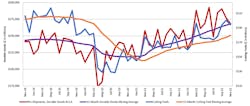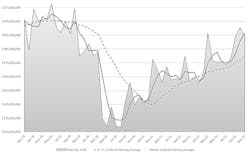Machine shops and other U.S. manufacturers began to decelerate their activities during the last quarter of 2022, as indicated by the -3.1% drop in cutting-tool consumption from October to November. The $194.4 million total for November still indicated a 20.8% improvement over the November 2021 consumption total, and boosted year-to-date cutting-tool consumption to $2.0 billion, a 10.4% increase over the January-November 2021 total.
Cutting tools are consumable products, the purchases of which serve as an index to overall manufacturing activity due to the range of market segments driving machine shops’ purchases. The data is compiled by the U.S. Cutting Tool Institute and AMT – the Assn. for Manufacturing Technology for their monthly Cutting Tool Market Report, which represents actual purchases of cutting tools as reported by manufacturers and distributors that comprise a majority of the domestic market for cutting tools.“Cutting tool consumption is on pace with durable goods production, a positive sign that supply chain issues and shortages of raw materials are easing,” according to Jack Burley, who chairs AMT’s Cutting Tool Product Group and Committee. “Despite fears of a recession, cutting tool usage has not been affected so far, and industrial production capacity remains steady.”
The CTMR differs from the monthly U.S. Manufacturing Technology reportv issued by AMT, which is a forward-indicator of manufacturing activity based on machine shops’ investments in capital equipment. Over recent months, the USMTO index has been declining as a result of supply-chain disruptions, rising interest rates, and other factors slowing future orders for manufactured parts.
“The GDP measures durable goods, non-durable goods, and services, so is it possible that the forecasted recession will largely avoid durable goods,” observed Costikyan Jarvis, president of Jarvis Cutting Tools.
“The 12-month CTMR average is only 90% of pre-pandemic levels,” Jarvis continued. “Commercial aerospace production is still recovering, and the automotive market, after only selling 13.7 million units, has the possibility to stay flat.”







